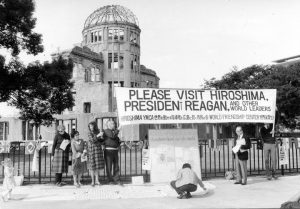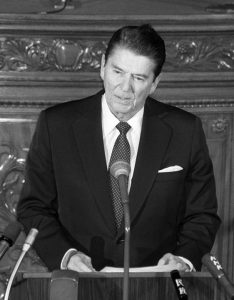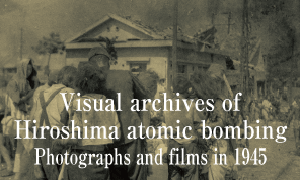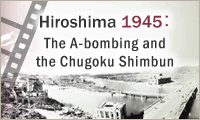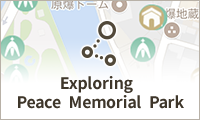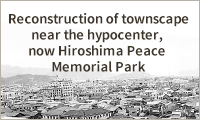Documenting Hiroshima 80 years after A-bombing: In November 1983, Ronald Reagan pays visit to Japan
May 8, 2025
Citizens lobby for visit to Hiroshima
by Kyosuke Mizukawa, Senior Staff Writer
On November 9, 1983, in front of the A-bomb Dome, located in Hiroshima City’s Naka Ward, a group of Hiroshima citizen volunteers raised a horizontal banner reading, “PLEASE VISIT HIROSHIMA.” On that day, Ronald Reagan, president of the United States, the nuclear superpower that had dropped the atomic bombs, arrived in Japan.
The gathered citizens were members of the Invite Reagan to Hiroshima campaign office. Kazumitsu Aihara, the campaign’s representative and executive director of the Hiroshima YMCA who died in 2006, made the following appeal to Mr. Reagan — “You must find the time to visit Hiroshima and etch the reality of the atomic bombing into your soul.” Americans living in Hiroshima who supported the idea also joined the campaign.
Fundraising begins
In the early 1980s, tensions between the United States and the Soviet Union had been escalating. In Europe, a growing anti-nuclear movement known as “No Euroshima” (in an attempt to prevent Europe from becoming a nuclear battlefield akin to Hiroshima) had been spreading across the continent in response to the deployment of nuclear missiles and a growing sense of crisis over the threat of nuclear war. The Invite Reagan to Hiroshima campaign aimed to bring about the first visit to Hiroshima by a sitting U.S. president as a kind of “vow to prevent nuclear war.”
Prior to Mr. Reagan’s Japan visit, a fundraising campaign for placement of an advertisement in a U.S. newspaper calling for the president’s visit to Hiroshima had been launched. On October 10, 1983, around one month before the U.S. president’s visit, the Washington Post carried a full-page advertisement that called on President Reagan to, “Please visit Hiroshima” and featured a silhouette of the A-bomb Dome.
Members of the campaign also sent a letter to the U.S. Embassy in Japan requesting the presidential visit. Referring to a passage in the Appeal for Peace written by Pope John Paul II, who had visited Hiroshima City in 1981, the ad stated, “To remember Hiroshima is to abhor nuclear war.” The Embassy replied with their promise to forward the letter to the United States.
Mr. Reagan stayed in Japan through November 12. He attended summit meetings with Japan’s then-Prime Minister Yasuhiro Nakasone, but his schedule was said to not allow him the time to visit Hiroshima.
However, in his speech to Japan’s parliamentary Diet on November 11, Mr. Reagan prefaced his speech by saying that America’s wishes were shared by Mr. Nakasone and all of Japan, adding that “nuclear war cannot be won and must never be fought.” He also spoke about America’s dream to witness a day when all nuclear weapons were abolished from the face of the Earth.
In May 1984, the following year, former U.S. President Jimmy Carter visited Hiroshima City on his trip to Japan in response to an invitation by a private corporation in Japan. He offered a wreath of flowers at the Cenotaph for the A-bomb Victims, explaining his solemn feelings when he thought of the devastating catastrophe of the atomic bombings, adding his feeling that the historical lesson of the bombings must never be forgotten. In December of that same year, David Emery, Deputy Director of the U.S. Arms Control and Disarmament Agency, visited Hiroshima and toured the Hiroshima Peace Memorial Museum.
Delegation sent to United States
Japanese citizens continued their lobbying efforts to invite Mr. Reagan to Hiroshima. In June 1985, the Japan Confederation of A- and H-Bomb Sufferers Organizations (Nihon Hidankyo) sent a delegation, headed by Senji Yamaguchi, a survivor of the atomic bombing of Nagasaki, to the United States. They submitted a letter to the U.S. State Department requesting that Mr. Reagan work toward the abolition of nuclear weapons and visit Hiroshima and Nagasaki.
Five months later, in November, amid the continued citizens’ anti-nuclear movement in Europe, a summit meeting was held in Geneva, Switzerland, between U.S. President Ronald Reagan and Communist Party General Secretary Mikhail Gorbachev of the Soviet Union. Afterward, they released a joint statement announcing that “nuclear war cannot be won and must never be fought,” thereby accelerating nuclear disarmament negotiations. In December 1987, the United States and the Soviet Union signed the Intermediate-Range Nuclear Forces (INF) Treaty, the first accord in history aimed at eliminating a specific category of nuclear weapons.
In 1981, Ichiro Moritaki, 86 at the time, who was the first co-chair of Nihon Hidankyo, traveled to Europe and spoke at an anti-nuclear gathering there. He said that the agreement between the United States and the Soviet Union had given him “confidence that the people’s movement will not suffer from repeated setbacks,” remarks that were reported in the Chugoku Shimbun published on November 25, 1987. Mr. Moritaki sent letters to Mr. Reagan and Mr. Gorbachev applauding the INF Treaty and calling for the abolition of all nuclear weapons.
(Originally published on May 8, 2025)

